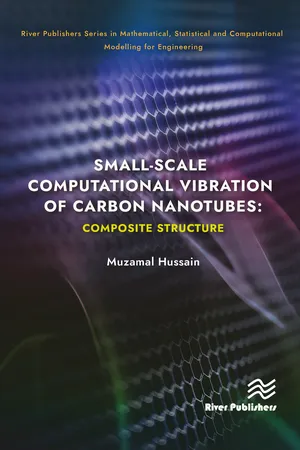
Small-scale Computational Vibration of Carbon Nanotubes: Composite Structure
- 174 pages
- English
- ePUB (mobile friendly)
- Only available on web
Small-scale Computational Vibration of Carbon Nanotubes: Composite Structure
About This Book
This book presents orthotropic vibration modeling and analysis of carbon nanotubes (CNTs) which be helpful in applications such as oscillators and in non-destructive testing, and also vibrations characteristics of armchair double-walled CNT by means of nonlocal elasticity shell model. The nonlocal shell model is established by inferring the nonlocal elasticity equations in to Kelvin's theory, which is our particular motivation. The suggested method to investigate the solution of fundamental Eigen relations is wave propagation, which is a well-known and efficient technique to develop the fundamental frequency equations. The frequencies of three different types of SWCNTs are calculated. Also, the vibrations of the chiral single-walled carbon nanotube (SWCNTs) with non-local theory using wave propagation approach is investigated. It has been investigated that by increasing the nonlocal parameter decreases the frequencies and on increasing the aspect ratio increases the frequencies throughout the computation frequencies of clamped-free lower than that of clamped-clamped.
Carbon nanotubes have a variety of applications because of their distinctive molecular structure and show unique electronic and mechanical properties because of their curvature. Nanotubes and micro-beams can be cited as one of the very applicable micro- and nano-structures in various systems, namely, sensing devices, communications and the quantum mechanics. The application of the tiny structures, specifically, carbon nanotubes in the sensors and actuators enforce the engineers to study vibrational properties of those structures experimentally and theoretically. In addition, they are utilized in different fields such as bioengineering, tissue engineering, computer engineering, optics, energy and environmental systems.
Frequently asked questions
Information
Table of contents
- Cover Page
- Half Title page
- Series page
- Title Page
- Copyright Page
- Dedication
- Contents
- Preface
- Acknowledgments
- List of Figures
- List of Tables
- List of Notations
- List of Abbreviations
- Abstract
- 1 Introduction
- 2 Single-walled Carbon Nanotubes Modeled as Flügge Shell Theory: Influences of Length-to-Diameter Ratios 2
- 3 Accuracy of Stiffness on the Vibration of Single-walled Carbon Nanotubes: Orthotropic Shell Model
- 4 Donnell Shell Theory Formulation – Single-walled Carbon Nanotubes: Frequency Assessment via Height-to-Diameter Ratios
- 5 Impact of Poisson's Ratios on the Vibration of Single-walled Carbon Nanotubes: Prediction of Frequencies through Galerkin's Technique
- 6 Wave Propagation in Single-walled Carbon Nanotubes via Euler Beam Theory
- 7 Concluding Remarks/Summary/Future Recommendation
- Appendices
- Index
- About the Author